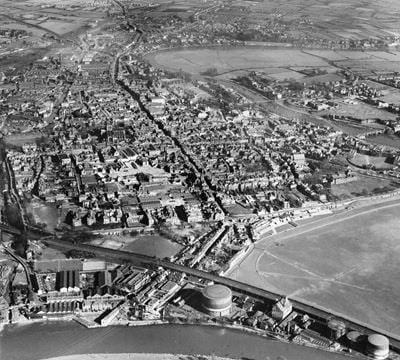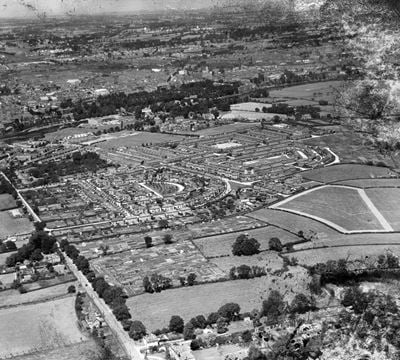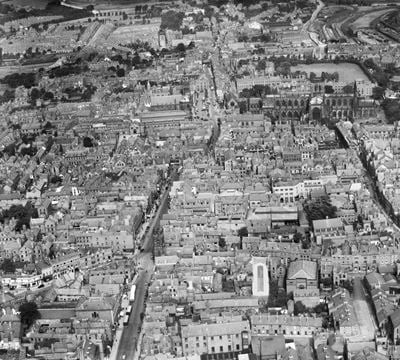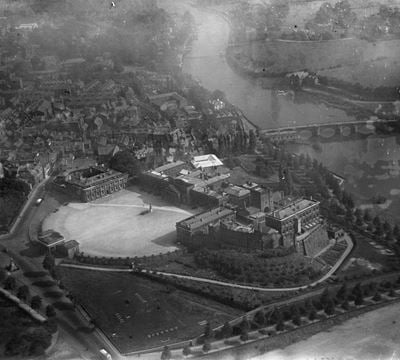Chester
Explore hidden histories, historic photos, and things you never knew about Chester from the collections and archives of Historic England.
Discover your local listed buildings and places
Introducing some of Chester's most historic sites, included in the National Heritage List for England. Some of these captions have been summarised by AI. Click through for the official List entry. Skip this section and go to place by numbers
Cathedral Church of Christ and the Blessed Virgin Mary
Chester
The Cathedral Church of Christ and the Blessed Virgin Mary in Chester is significant for its historical associations with figures such as Abbot Richard and Abbot Simon Ripley.
Taylor's Boatyard (including Former Flat Shed, Narrowboat…
Chester
Canal boatyard, mid-C19 with later additions and alterations, built for the Shropshire Union Railways and Canal Company.
Number 37 Street Number 45 Row St Ursulas
Chester
The building features a Grade I listed undercroft dating from the late 12th century, with historical architectural elements and modern alterations.
The Eastgate and clock
Chester
The Eastgate and clock in Chester, featuring a clock tower by John Douglas, was completed in 1899, financed by Lord Grosvenor and Colonel Edward Evans-Lloyd.
Number 48 and 50 Street Numbers 48, 50 and 52 Row Three O…
Chester
Number 48 and 50 Street/Row have historical significance as part of Chester's architecture.
Number 17 Street Number 21 Row Leche House
Chester
Leche House, a historic Chester landmark, showcases late 14th-century undercroft, ornate timber framing, and intricate plasterwork. Once the Leche family's home, it now houses shops.
Number 11 Street Numbers 15 and 15A Row the Old Crypt
Chester
No.11 Street and Nos.15 & 15A Row, known as The Old Crypt, feature medieval and Georgian architecture, with significant undercroft dating to circa 1300.
Bear and Billet Public House
Chester
The Bear and Billet Public House, built in 1664 for the Earl of Shrewsbury, is an architecturally significant timber-framed building in Chester, now serving as a public house.
South East Angle Tower and Wall of Roman Legionary Fortress
Chester
Summary of the 1st-century to 2nd-century Roman Legionary Fortress, known for its purple-grey ashlar sandstone base and remaining foundation structures in Chester.
St Marys Centre
Chester
St Mary's Centre in Chester is a historic parish church turned educational center, featuring notable stained glass, monuments, and a rich architectural history from the 14th century onward.
13 and 15 Watergate Street and 17 and 19 Watergate Row South
Chester
A pair of medieval shops and town houses with open stalls at Row-level, over undercrofts at Street-level, re-built and altered during the C18, C19 and C20.
Spur Wall and Water Tower
Chester
The Spur Wall and Water Tower in Chester, built by John Helpstone between 1322-6, features medieval crenellation and was crucial for commanding the medieval port.
Number 10 Row Cowper House Number 12 Street
Chester
Number 12 Bridge Street and 10 Bridge Street Row West features a mid-17th-century timber-framed townhouse atop an early-13th-century stone undercroft linked with Thomas Cowper.
Church of St Peter
Chester
The Church of St Peter is historically significant, founded in 907AD by Aethelfled on a Roman site. It underwent various restorations from the 14th to 19th centuries.
Remains of Roman Amphitheatre
Chester
The Remains of Roman Amphitheatre in Chester City, a Grade I listed site, includes parts of the lower stonework from the 2nd-century structure.
Number 41 Street Numbers 51 and 53 Row Bishop Lloyds House
Chester
Number 41 Street, Bishop Lloyd's House, features medieval undercrofts transformed into shops. Key historical figures include George Lloyd, Bishop of Sodor and Man, and Chester.
The Watergate
Chester
The Watergate, a Grade I listed archway through Chester's city wall, built by Joseph Turner in 1788-90, features rusticated sandstone and historical significance dating back to medieval...
Numbers 28 and 30 Row Booth Mansion Numbers 28-34 Street
Chester
Located in Chester, Numbers 28-34 feature medieval and 18th-century architecture, originally built for George Booth, and now house Sotheby's Auction Galleries.
Falcon Inn
Chester
The Falcon Inn, a Grade I listed building in Chester, dates back to around 1180 and is notable for its medieval architectural features and historical significance.
Former Monastic Buildings to Cathedral Church of Christ a…
Chester
The former monastic buildings have origins dating back to the 12th century, featuring Norman and early English architecture, with significant restorations in the 19th and 20th centuries.
The Northgate
Chester
The Northgate in Chester, built in 1810 by Thomas Harrison, is a sandstone archway part of the City Walls, replacing a medieval gatehouse.
Abbey Gateway
Chester
The Abbey Gateway, built around 1300 and altered in the 19th century, served as the main entrance to St Werburgh's Abbey, notable for its historical and architectural features.
Number 63 and 65 Street the Blue Bell
Chester
Number 63 and 65 Northgate Street in Chester, once the Blue Bell Public House and a shop, now form a restaurant. It's a notable example of medieval architecture.
Addleshaw Tower
Chester
Free-standing bell tower to Chester Cathedral, 1973-5, by George G. Pace. Reinforced concrete frame hung with Bethesda slates, pink sandstone ashlar base.
Presbytery of Roman Catholic Church of St Werburgh
Chester
Presbytery to Roman Catholic Church of St Werburgh, c1875 to designs by Edmund Kirby. Free Gothic style. Red brick with blue brick decoration, Westmorland slate roofs.
City Wall From Bonewaldesthorne Tower to Pembertons Parlour
Chester
The Chester City Wall, extending from Bonewaldesthorne Tower to Pemberton's Parlour, originates from the late 11th to early 12th century and includes elements added in the 18th and 19th...
Bonewaldesthorne Tower
Chester
Bonewaldesthorne Tower, documented since the 13th century, was rebuilt in 1322. It features red sandstone, battlements, and a notable history as part of Chester's defensive structures.
Pembertons Parlour
Chester
Pemberton's Parlour, also known as Goblin Tower, is a reconstructed gazebo on Chester's City Walls site named for John Pemberton, a former mayor.
Part of City Wall From Pembertons Parlour to St Martins G…
Chester
This section of the Chester city wall, dating from the late 11th to early 12th century, was converted to a promenade in the early 1700s.
Part of City Wall From St Martins Gate (Not Included) to …
Chester
This section of Chester's City Wall, dating from the late 11th to early 12th century, incorporates Roman and medieval elements, forming a historic raised promenade.
Phoenix Tower
Chester
Phoenix Tower, also known as King Charles' Tower, has historical significance. King Charles stood here in 1645 during the Civil War to witness his army's defeat at Rowton Moor.
Part of City Wall From Northgate to Phoenix Tower
Chester
Part of the Chester City Wall, dating from the late 1st to early 2nd century, features Roman and medieval masonry with significant historical repairs.
Part of City Wall Between Morgans Mount and Northgate
Chester
The part of the City Wall between Morgan's Mount and Northgate reflects Chester's historical layers, from its early 2nd-century Roman origins to medieval enhancements and 18th-century...
Number 10 Bridge Street, and Number 8 (part) Bridge Stree…
Chester
Undercroft and town house forming part of the Chester Rows, with a small warehouse to the rear. Now a shop and office. C17 with late-C19 and C20 alterations but may have earlier origins.
Number 39 Street
Chester
Number 39 Bridge Street features a medieval undercroft, now a café. It includes original medieval structures and Roman bath-house masonry, reflecting its historical significance.
Part of City Wall From Phoenix Tower to Kaleyard Gate
Chester
The city wall from Phoenix Tower to Kaleyard Gate, part of Chester's historic defenses, features Roman and medieval construction using local sandstone.
Kaleyard Gate
Chester
Kaleyard Gate is a medieval pedestrian gateway through Chester's City Walls, created around 1275 for St Werburgh's Abbey monks. It remains in near-original form and is closed nightly.
Number 28 Street Number 34 Row Crypt Building
Chester
Number 28 Street and Number 34 Row, known as the Crypt Building, features a medieval undercroft and early department store elements designed in 1858 by TM Penson.
Explore more
Search for more listed placesChester through time
This timeline shows the first period of use for buildings and places on the National Heritage List for England, just one of the details recorded for every list entry. Click around to see how Chester changes over time. Skip this section and go to aerial photos
Prehistoric Before AD 43
Prehistory covers a million years of human occupation before the Roman invasion, from hunter-gatherers of several human species, including Neanderthals, to more recent herders and farmers. It was a time of developing technologies and belief systems, involving contact with and migration from Europe, all reflected in the variety of artefact and monument types characteristic of particular prehistoric periods.
Roman AD 43 to AD 410
Britain was invaded by four legions of the Roman army in AD 43, who relatively rapidly conquered England from landing points in Kent. Parts of Wales and Scotland soon followed.
Roman culture brought urbanism, monumental buildings, wide-ranging religious beliefs, writing, and strong social hierarchy. The Roman administrative system was withdrawn in AD 410.
Early medieval AD 410 to AD 1066
This period, often associated in England with Anglo-Saxons and Vikings, saw a reduction in urban living from the Roman period and increased migration from northern Europe.
Traces of this period can be found in cemeteries, particularly in artefacts and in some of the very early churches, as this period also saw the growth of Christianity in Britain.
Medieval AD 1066 to AD 1540
This period, sometimes known as the Middle Ages, began with the Norman invasion in AD 1066. It saw a significant rise in military and defensive buildings such as castles and earthworks, as well as religious houses dominating a largely agricultural landscape.
The monarchy and Church dominated the period, which also saw the break with the Roman Catholic Church and the English reformation.
Post medieval AD 1540 to AD 1901
The Post-Medieval period brought seismic changes to life in England, with religious reformation leading to the democratization of worship and the destruction of hundreds of religious houses.
In parallel, there was a huge expansion of scientific study and enlightenment that permanently altered the nation's social structure and landscape. Industrialization and mass production lead to wider global trade, emigration, and immigration.
20th century AD 1901 to AD 2000
The 20th century saw an incredible expansion of England's transport networks, with suburban growth shadowing rapid infrastructural expansion. The establishment of state schools, hospitals, and modern technical colleges, with new architectural styles, radically changed the appearance of towns and cities.
Two catastrophic world wars and the 1918 pandemic also brought unprecedented change, altering England's built environment and social structures forever.
Prehistoric Before AD 43
Prehistory covers a million years of human occupation before the Roman invasion, from hunter-gatherers of several human species, including Neanderthals, to more recent herders and farmers. It was a time of developing technologies and belief systems, involving contact with and migration from Europe, all reflected in the variety of artefact and monument types characteristic of particular prehistoric periods.
Roman AD 43 to AD 410
Britain was invaded by four legions of the Roman army in AD 43, who relatively rapidly conquered England from landing points in Kent. Parts of Wales and Scotland soon followed.
Roman culture brought urbanism, monumental buildings, wide-ranging religious beliefs, writing, and strong social hierarchy. The Roman administrative system was withdrawn in AD 410.
Early medieval AD 410 to AD 1066
This period, often associated in England with Anglo-Saxons and Vikings, saw a reduction in urban living from the Roman period and increased migration from northern Europe.
Traces of this period can be found in cemeteries, particularly in artefacts and in some of the very early churches, as this period also saw the growth of Christianity in Britain.
Medieval AD 1066 to AD 1540
This period, sometimes known as the Middle Ages, began with the Norman invasion in AD 1066. It saw a significant rise in military and defensive buildings such as castles and earthworks, as well as religious houses dominating a largely agricultural landscape.
The monarchy and Church dominated the period, which also saw the break with the Roman Catholic Church and the English reformation.
Post medieval AD 1540 to AD 1901
The Post-Medieval period brought seismic changes to life in England, with religious reformation leading to the democratization of worship and the destruction of hundreds of religious houses.
In parallel, there was a huge expansion of scientific study and enlightenment that permanently altered the nation's social structure and landscape. Industrialization and mass production lead to wider global trade, emigration, and immigration.
20th century AD 1901 to AD 2000
The 20th century saw an incredible expansion of England's transport networks, with suburban growth shadowing rapid infrastructural expansion. The establishment of state schools, hospitals, and modern technical colleges, with new architectural styles, radically changed the appearance of towns and cities.
Two catastrophic world wars and the 1918 pandemic also brought unprecedented change, altering England's built environment and social structures forever.
Aerial photos of Chester
Aerial photography helps reveal secrets of England's changing landscapes that are impossible to see from the ground. Skip this section and go to archive images

Chester
Chester Castle, Chester, 1920

Chester
Chester Castle, County Hall and St Mary on the Hill Church, Chester, 1948

Chester
The Cathedral Church of Christ and the Blessed Virgin Mary and environs, Chester, 1920

Chester
The city centre, Chester, 1948

Handbridge
New housing at Watling Crescent, Handbridge, 1931

Chester
Housing estate at Handbridge, Chester, 1938

Chester
Watergate Street and Eastgate Street, Chester, 1929

Chester
Eastgate Street and the city centre, Chester, 1931

Chester
Bridge Street and the city centre, Chester, 1932

Chester
Chester Castle and Assize Courts, Chester, 1931
Chester in the Historic England Archive
The Historic England Archive cares for over 15 million images, dating from the 1850s to the present day. Discover stunning images of Chester's past. Skip this section and go to stories about heritage
Charles George Harper Collection
Chester, Cheshire West And Chester
Date created: 1892 - 1933
The base and shaft of the cross known as the Roodeye Cross
Eileen ‘Dusty’ Deste Collection
Chester, Cheshire West And Chester
Date created: 1965 - 1968
A view looking across the Shropshire Union Canal towards the King Charles Tower, aka Phoenix Tower, on the Chester City Walls
Eric de Mare
Chester, Cheshire West And Chester
Date created: 1945 - 1980
Interior view of St John the Baptist's Church in Chester.
London, Midland and Scottish Railway Company
Chester, Cheshire West And Chester
Date created: Jun 1894
A busy Bridge Street viewed from the south
Nigel Temple Collection of Postcards of Parks and Gardens
Chester, Cheshire West And Chester
Date created: 1900 - 1920
EXTERIOR VIEW OF STEPS TO PARAPET
Walter Scott
Chester, Cheshire West And Chester
Date created: 1920 - 1935
A view looking north along Lower Bridge Street from The Bridgegate
Charles George Harper Collection
Chester, Cheshire West And Chester
Date created: 1892 - 1933
Looking along the walkway of one of Chester's Rows, showing people outside the shops
Eileen ‘Dusty’ Deste Collection
Chester, Cheshire West And Chester
Date created: 1965 - 1968
A view looking across the Shropshire Union Canal towards the King Charles Tower, aka Phoenix Tower, on the Chester City Walls
Eric de Mare
Chester, Cheshire West And Chester
Date created: 1945 - 1980
General view of Bridge Sreet row in Chester from the National Farmers' Union.
London, Midland and Scottish Railway Company
Chester, Cheshire West And Chester
Date created: 1880 - 1900
A view looking east along Eastgate Street from the upper storey of a building on the corner of Bridge Street and Watergate Street
Walter Scott
Chester, Cheshire West And Chester
Date created: 1920 - 1935
The exterior of The Old King's Head Inn on Lower Bridge Street, with a boy standing on the street in front
Walter Scott
Chester, Cheshire West And Chester
Date created: 1936
A view of moorings at the east end of The Groves, from the west
Stories about heritage in your local area
Historic England publishes news, blogs, research, videos, and podcasts celebrating England's rich heritage. Discover the stories we have about Chester. Skip this section and go to education
The Legend of King Arthur
Mentions Remains of Roman Amphitheatre
King Arthur was central to the legendary tales of medieval romance. Discover the places connected to Camelot, Tintagel, and the Battle of Badon Hill.
6 Historic Sites Added to the Heritage at Risk Register
Mentions Propylaea
Our Heritage at Risk Register is an annual snapshot of the health of England’s heritage.
Mentions Chester
Have you ever wondered what a listed building is? In this video, we look at three examples of listed buildings on the National Heritage List for...
What Is a Listed Building? (And Why They Matter)
Have you ever wondered what a listed building is? In this video, we look at three examples of listed buildings on the National Heritage List for England and explore what makes them special.
Mentions Chester
Picturing High Streets was a 3-year partnership between Historic England and photography champions @photoworks_uk, who worked with 9 regional partner...
How Photography Captured England’s Changing High Streets
Picturing High Streets was a 3-year partnership between Historic England and photography champions @photoworks_uk, who worked with 9 regional partner photography organisations to create a contemporary picture of England’s high streets.
Roman Richborough
Mentions Chester
Recent work allows a new plan or Richborough Roman fort to be presented and contributes to understanding a site of international importance.
Gods and Goddesses, Heroes and Heroines in the Nene Valley
Mentions Chester
The discovery of an important group of Roman sculpture fragments in the Nene Valley.
The Military Town and Bathhouse of Birdoswald Fort on Hadrian’s Wall
Mentions Chester
Recent excavation has provided important new understanding of the extramural settlement outside the fort.
Picturing High Streets: Over 200 Images Taken by the Public Enter Historic England Archive
Mentions Chester
Documenting a year in the life of the English high street, images taken by the public as part of 'Picturing High Streets' can be viewed online.
Research Reports Roundup May 2023
Mentions Chester
An overview of additions to our Research Reports Database in February to May 2023.
Research Reports Roundup November 2022
Mentions Chester
An overview of additions to the Historic England Research Reports database from January to November 2022.
Rare Travellers’ Rest Stones in North of England Listed
Mentions Chester
Designed by a doctor 160 years ago, they created the perfect seat for migrant workers travelling on foot for seasonal agricultural work in the 1860s.
Grant Awarded to Rare Horticulture Heritage Site
Mentions Chester
The grant will help to repair three delightful summer houses in Coventry’s Victorian era Stoney Road Allotments.
Picturing High Streets: Major National Photography Competition Launched
Mentions Chester
Look at the high street as never before and share your photographs to a fortnightly challenge that will uncover the secret lives of our high streets.
Heritage and Craft Workers Across England Given a Helping Hand
Mentions Chester
142 historic sites across England are receiving grants worth £35 million through the government’s Culture Recovery Fund.
High Streets Heritage Action Zones’ Cultural Programme Awards £6 Million Grants
Mentions Chester
Over 60 High Streets Heritage Action Zones will receive grants totalling £6 million going to local arts organisations for community-led activities.
Five Metal Detectorists Sentenced in Biggest Operation of its Type
Mentions Chester
A Tameside nighthawking gang has been sentenced after admitting unlawful metal detecting at Beeston Castle, Cheshire and Roche Abbey, South Yorkshire.
Chester's social history through photos
Over 10,000 images from the Historic England Archive have been specially selected and re-captioned for teachers, students, and anyone who wants to learn more about their local area. Skip this section and go to grant-aided places
Watergate Street, Chester, Cheshire
Period: Stuart (1603 - 1713)
View along Watergate Street.
Watergate Street, Chester, Cheshire
Watergate Row, Watergate Street, Chester, Cheshire
Period: Victorian (1837 - 1901)
General view along Watergate Row
Tudor House, Chester, Cheshire
Period: Stuart (1603 - 1713)
This timber framed shop was once a large town house. It was probably built in 1603. It was extended and altered in the 17th and 18th centuries.
Tudor House, Chester, Cheshire
Town Crier Public House, Chester, Cheshire
Period: Victorian (1837 - 1901)
This former hotel was built in 1865. It is built in an Italianate style of architecture. It was known as The Albion Hotel.
Town Crier Public House, Chester, Cheshire
Statue of Richard Grosvenor, Chester, Cheshire
Period: Victorian (1837 - 1901)
This statue is of Richard Grosvenor, the second Marquis of Westminster. It was built in 1869 by Thomas Thornycroft.
Statue of Richard Grosvenor, Chester, Cheshire
St Mary's Rectory, Overleigh Road, Handbridge, Chester, Cheshire
Period: Victorian (1837 - 1901)
Exterior of Handbridge Rectory, a large late Victorian house by Grayson & Ould.
St Mary's Rectory, Overleigh Road, Handbridge, Chester, Cheshire
Tags
St Mary's Hill School, Cottage and Garden, Chester, Cheshire
Period: Victorian (1837 - 1901)
This school, cottage and walls were built in 1846.
St Mary's Hill School, Cottage and Garden, Chester, Cheshire
St Johns School, Chester, Cheshire
Period: Victorian (1837 - 1901)
Exterior of St Johns National Schools, Chester
St Johns School, Chester, Cheshire
Discover more
Ready for more local heritage? Take a look at these other places nearby

Cheshire West and Chester
Local Authority District

Cheshire
Ceremonial County

Halton
Local Authority District